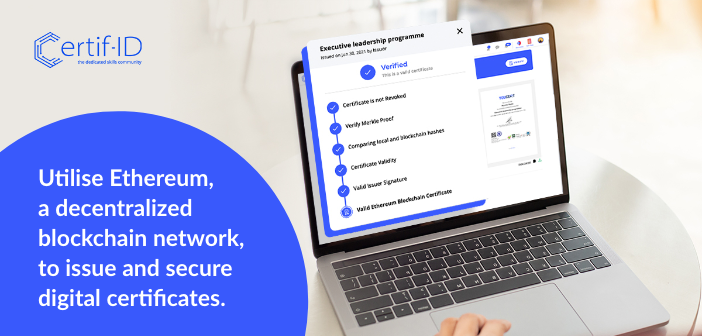From the beginning of 2017, there has been a constant hype around blockchain technology. On one hand we see numerous use cases of blockchain and its adoption outside of FinTech. On the other hand, many organisations are still struggling to realise its actual value.
In this two-part blog, we will discuss a few use cases. The introduction to Ethereum blockchain-based digital certificates and its unprecedented value; with a specific focus on how it can help government bodies, educational institutions, corporates and banks.
Introduction to Ethereum Blockchain-Based Digital Certificates
Now, we are not talking about PDFs as digital certificates but certificates that are electronically issued through an Ethereum blockchain-powered platform.
The platform powered by Ethereum blockchain establishes a secure framework for conducting electronic transactions. It instills trust between the issuer and the recipient and acts as a single source of truth by maintaining an immutable transactions database.
The framework ensures that the person in possession of a digital certificate issued on the Ethereum Blockchain is in fact the same person whose identity is attested to by the certificate.
Digital certificates issued on Blockchain are the future of securing online transactions. From educational institutions to banks, issuing certificates on Blockchain is going to become mainstream. As a matter of fact, many organisations and governments have already implemented blockchain technology into their system.
History of blockchain
Blockchain has certainly taken the world by storm. It is popularly known for being the underlying technology behind cryptocurrencies.
In the present times, you can see the use of this technology in multiple industries.
But, where did it start from? How did it reach this stage? Here is a short overview of the history of blockchain.
| The Blockchain Timeline
1991: While the term blockchain has become popular in the media, the technology was actually proposed as early as 1991 by Stuart Haber and W. Scott Stornetta. The duo believed that time-stamping digital documents could be an effective way to prevent tampering. 1998: Computer scientist Nick Szabo started working on bit gold, a decentralized digital currency. It was never implemented. 2000: Stefan Konst released his theory of cryptographic secured chains, as well as ideas on how to implement it. 2004: Hal Finney, a computer scientist, introduced the concept of Reusable Proof Of Work (RPoW). 2008: The pseudonymous Satoshi Nakamoto released a white paper proposing the model for a blockchain. 2009: Satoshi Nakamoto adapted blockchain as one of the core technologies that power bitcoin. 2014: Blockchain technology, which was originally used only to exchange currency, entered the early stages of being applied to other applications. It was the beginning of Blockchain 2.0. 2015: Ethereum was launched as the first Blockchain 2.0. 2017: Initial coin offerings and blockchain-based projects became common. |
 Blockchain is rising to be one of the most sought-after technologies
Blockchain is rising to be one of the most sought-after technologies
There are numerous advantages of issuing digital certificates on Ethereum Blockchain. Here are some of the most common advantages that we’ve compiled in the form of a list:
- Digital certificates are portable
Unlike physical certificates, digital certificates issued on Ethereum Blockchain do not have to be carried around. It will exist forever on the Blockchain network and can be accessed on any device, from anywhere.
- Digital certificates as ID proof
Blockchain-based digital certificates are modern replacements for traditional paper identification proofs. Issued on a highly secure Ethereum Blockchain framework, the verifiable digital certificates can be traced back all the way to the issuer. Thereby, making the entire process transparent – from the certificate issuer to receiver.
- Used for micro credentialing
As almost any form of data can be encrypted into a blockchain-based digital certificate, organisations can issue micro-credentials to recognise learning, career skills, internship completion, etc. This would certainly help both organisations and individuals in the age of niche skills.
- Used for data security
Paper-based certificates can take days and weeks to issue, verify and dispatch. Moreover, the certificates can be modified without the knowledge of the issuing institute. On the contrary, blockchain-based digital certificates cannot be modified by anyone. If the certificate is tampered with then its verification will fail. Thereby making the data held within a digital certificate 100% safe and traceable at all times.
- Low cost
Utilising blockchain technology does not have to be a costly affair. Through Ethereum blockchain-powered platforms like Certif-ID, organisations can issue digital certificates for a variety of services, easily. The Certif-ID platform does not need additional hardware or software to use. It can be used on any device with an internet connection and digital
certificates can be issued and distributed at a fraction of the cost of paper certificates.
Student records or data repository
Blockchain technology is being put to use in a variety of fields that are not associated directly with cryptocurrencies, including academic certification and student record maintenance. The traditional record-keeping and certification process has its own set of challenges. Blockchain solves these problems and makes it easy for educational institutions to maintain the students’ records safely, recruiters to verify students’ credentials, and students to prove their skills.
Also read: Why governments need to endorse Ethereum to issue certificates https://nationalskillsnetwork.in/why-governments-need-to-endorse-ethereum-to-issue-certificates/
Digital certificates issued on blockchain streamlines the entire certification process. In the next blog, we will delve deeper into use cases of digital certificates, how blockchain tackles fake certificates, and how you can start issuing digital certificates.
If you’ve any questions, feel free to write to us or book a meeting with us.














Comments 1